In North America, economic production from unconventional shale reservoirs has significantly impacted local, national and global economies. However, there is a general deficiency of engineering tools for these assets. Much of the success within these fields can be attributed to a combination of innovative thinking, rapid deployment and incremental improvement. Compared to Barnett shale development through the early 2000s, the time required to create economic solutions has been reduced significantly during more recent operations, such as those in the Eagle Ford.
However, using conventional techniques, even relatively minor step-out projects, can be very difficult because of the extreme variation of reservoir characteristics. To help minimize these problems, a new reservoir-centric solution has been created and tested, along with tools to help geoscientists and engineers collaborate more effectively and accelerate the optimization of an unconventional shale development. A field example of a step-out development in the Barnett is also examined, showing how these tools can be used to place the exact lateral location more effectively and complete wells to improve consistency and productivity.
Reservoir-centric solution. Within higher-risk assets, such as deep water, the use of multi-disciplinary teams to carefully model, plan and develop assets has become commonplace. Within many of these high-cost assets, the lines between the disciplines of geosciences, reservoir engineering, drilling and completions often becomes blurred, forcing people to work much more closely to arrive at an optimized solution. However, during most land-based operations, a more conventional model of multiple discipline-specific teams is still quite common, so that not all objectives and success criteria are aligned.
In many cases, the key performance indicators are cost-oriented, focusing on reducing the costs of drilling and completing complex wells within even more complex reservoirs. This model often results in drilling decisions that are not well-aligned with the well and completion designs necessary to maximize asset performance.
It was determined that a much more reservoir-centric solution was necessary to reap the maximum benefit from unconventional shale reservoirs. Upon examining the issues further, it was observed that most of these reservoirs could be characterized more accurately as source rock reservoirs. This means that each of them has a very complex geologic history, which must be modeled carefully to understand true production potential. Reservoir characterization requires the integration of several disciplines, including basin modeling, core analysis, geochemistry, petrophysics, geology and geophysics. This is a relatively conventional exploration and appraisal process, but the variability in these reservoirs, combined with the extremely low reservoir quality, means that some capability to high-grade specific reservoir attributes is necessary, to help maximize asset value.
Implementation of this process requires a significant effort and cooperation across multiple disciplines. Challenges revolve around effectively managing data from multiple sources, providing useful information and set time-performance objectives that account for the interdependence of well placement, completion design and well productivity performance.
For a full asset development project, Fig. 1 provides a framework that can create a common platform, which combines information and data from multiple sources to help enable creation of a regularly updated, integrated subsurface model. This includes monitoring activities in near real time, displaying the past, present and future wells within the modeled reservoir. The model can be updated regularly, as new well information becomes available, to help create a single environment from which geoscientists, reservoir engineers, drilling engineers, and production engineers can work and collaborate.
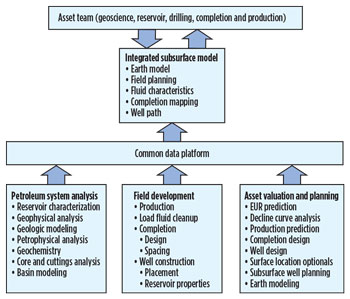 |
| Fig. 1. Integrated data platform and incorporation of a common subsurface model that can be used by multiple disciplines. |
|
In the past, hydraulic fracturing has been used to achieve reservoir contact vertically, above and below a horizontal wellbore. The variation in rock properties, from layer to layer within these reservoirs, can significantly impact the ability to create a desired fracture height and/or sustain fracture conductivity through some of these layers. As a result, improved wellbore placement within the reservoir is a key enabler for improved fracture placement and completion performance.
Maximizing asset value has become an exercise to help ensure proper well placement and hydraulic fracture treatments along the wellbore. Operational efficiency, and drilling and completion execution, are still very important, but understanding the reservoir and maximizing well productivity is also very important. This is a much more balanced approach, where optimization can be performed on the net present value (NPV) or return on investment (ROI), rather than the well cost and/or initial production rate.
Figure 2 illustrates how this process can be deployed, using an integrated subsurface model to help enable a more collaborative environment; use reservoir information to make better decisions; and improve the model and process throughout the development program. During this process, the subsurface model is updated regularly, using new well information and calibrated model information, helping to ensure that the most current, relevant data are always available to the asset team. This allows previous decisions to be reviewed, to evaluate whether near-term plans should be revised, not just long-term planning.
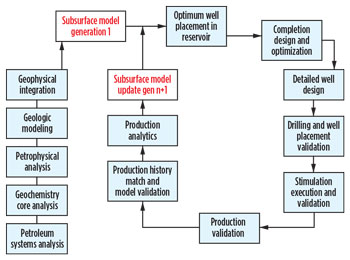 |
| Fig. 2. Field development process and workflows using a common subsurface model within a continuous improvement or refinement process. |
|
Reservoir characterization. Building the first-generation subsurface model or earth model is the primary goal of reservoir characterization. Within resource shales, many people consider these reservoirs to be relatively uniform, and reservoir risk is minimized. However, after several years of experience, the industry is learning that these reservoirs are actually very heterogeneous. They have many thinly bedded laminations with highly variable properties spanning the reservoir height, and have significant (but more gradual) variations laterally. In many cases, these reservoirs have significant structural features, which include karsts, faults and folds, making it difficult to plan and drill wells effectively without detailed geologic information. Because these can be classified as ultra-low-permeability source rocks, these reservoirs are in a state where the fluids are not equalized. Reservoir fluid properties can vary from dry gas to condensate to oil.
The integration of nearly every geologic tool available, beginning with petroleum systems analysis, is necessary to characterize a source rock reservoir. This includes basin and source rock modeling, core analysis, geochemistry, petrophysical analysis, geologic modeling and geophysics, followed by geostatistical earth modeling to create the most realistic subsurface model possible. Dusterhoft et al. provided a relatively detailed description of this process, which resulted in the creation of a detailed geo-cellular subsurface model.1 This is only the first-generation model. As the project progresses, this becomes the platform for capturing all present and future wellbore, drilling, formation evaluation, stimulation, production and reservoir information.
The idea of creating a constantly changing subsurface model, capable of accepting new information from multiple sources and updating locally, is not simple. It has required significant modifications to tools considered current and state-of-the-art. Many of these changes are still in development, including new solutions for gridding and meshing, to enable placement of complex wellbores, hydraulically induced fractures, existing natural fractures and faults, to help enable local updates and refinement, based on new information.
As a project progresses, this becomes a single environment that captures and retains all of the information about the reservoir and is made accessible to the entire asset team. This enables more effective collaboration, and the use of the most current asset information for well and completion designs. It also enables observation of all existing wellbores and stimulation treatments, current wells drilled or completed, and future wells and completions planned.
Well placement and planning. By using the subsurface model, higher-quality reservoir sections can be identified both regionally and stratagraphically, making it possible to identify higher-quality reservoir targets and improve well placement.
The subsurface model can be used as a map during horizontal well planning. By mapping surfaces, and even specific facies, it is possible to plan a well trajectory more accurately, to maximize the wellbore contact with the best-quality reservoir. Understanding specific facies properties and gamma response can also enable a geosteering plan to help drillers identify where they are, and keep the well within the desired reservoir target.
Reservoir simulation. Simulation is integral for tying well and completion designs to well performance. Initial completion designs incorporate reservoir simulation, based upon the most relevant information available in the subsurface model and is used to help optimize the completion and fracture treatment design, based upon expected or modeled productivity. After the well has been completed and placed on production, the reservoir simulation tool can be used in a production history matching mode, making corrections to key reservoir and completion attributes, to help ensure that actual production results are simulated effectively.
Under most normal circumstances, a reservoir study at this point would be completed. But in this case, it is only beginning, because the history-matched reservoir simulation model can be used to update and calibrate the properties in the subsurface model and hydraulic fracture simulation tool. This creates an iterative improvement process around reservoir model quality and hydraulic fracture design.
Hydraulic fracture simulation. The complexities of hydraulic fracturing with multiple stages, each with multiple fractures in a horizontal well, are becoming understood. If one considers this as multiple fractures competing for width within a highly stressed environment, the picture begins to take shape. Many of the modeling tools available today are based upon very basic assumptions, such as symmetric bi-wing fractures. However, when one considers the complex environment in which these horizontal wells are placed, this might no longer be a valid assumption, because stress interaction exists between adjacent fractures, fracturing stages, and even wellbores within a pad or infill development. Induced fractures tend to follow the path of least resistance, suggesting that new tools are necessary to model hydraulic fracture growth in this environment. Presently, the industry is beginning to observe that first-generation fracture design and simulation tools can help engineers model and understand fracture growth behavior in this complex environment, as well as aid better decision-making.
The coupling of these hydraulic fracture simulators with higher-end reservoir simulators can enable a very robust completions optimization process, making it possible to identify the fracture and reservoir characteristics that will have the greatest impact on well production.
Improved decision-making and planning. All of these tools are used within a collaborative environment to help engineers and geoscientists make better decisions about reservoir characterization, well placement, well and completion design (including fracture length and spacing, and stimulation treatment design), proppant size, concentration and volume. The ability to combine all of these with a common subsurface model, and incorporate all new reservoir, well, completion, and production information, provides the asset team with the most recent, advanced knowledge available to continuously improve well planning, drilling and completion throughout an asset’s life. This can speed up learning dramatically during exploration and appraisal. It also can help identify remediation and infield drilling opportunities during later development stages.
CASE HISTORY: BARNETT SHALE STEP-OUT DEVELOPMENT
In northeastern Wise County, Texas, 11 wells were drilled between 2006 and 2012, with varying results and without the luxury of 3D seismic data. The 3D seismic, covering 90 sq mi, was shot in 2011 and delivered in early 2012. The intent was to change this area from one of de-risking and appraisal to one of core development. A collaborative team was formed to characterize the reservoir, to capitalize on the people and skill sets of both the operator and service company.2
The targeted interval for these wells is the lower Barnett shale at about 7,500 ft, TVD. This lower Barnett layer is 400-ft thick, with a reservoir-quality interval of 235 ft.
Comprehensive reviews of previously drilled wells were performed, which included log correlations, geosteering data, borehole path on the 3D seismic, and completion design. Well performance indicated that this area was significantly different from the core Barnett development area, because the wells yielded higher oil and water volumes. The well reviews showed that most of the wells were inconsistent in their landing and target intervals. Also, production performance could be related to the amount of lateral within the target zone, as identified by the 3D seismic. Early completion designs were not consistent, and tended to reflect the designs being used within the dry gas wells in the higher-pressured core area.3
Reservoir understanding in source rock reservoirs. A subsurface model of the reservoir target was created, using a comprehensive process involving the acquisition of all available data and information, bringing everything together to create a detailed model, providing information on structural features, mineralogy, facies distribution, mechanical properties and reservoir characteristics.
This project phase used information from multiple logs and cores from wells within a reasonable proximity, as well as high-quality 3D seismic from this area. Completion of this phase revealed that the reservoir had a tremendous amount of vertical heterogeneity. When the early well surveys were inserted into this model, and well productivity was analyzed, the best-producing wells all penetrated a specific layer highlighted within the model, while wells that did not contact this layer had lower production. A clay-rich layer with a much higher Poisson’s ratio was also identified, just above the best-quality reservoir. This layer represented a geohazard, making it difficult to stimulate through effectively, and even more difficult to retain good fracture conductivity during production. These features have been identified within a vertical slice taken from the subsurface model, Fig. 3.
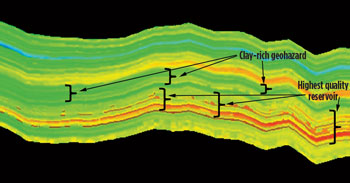 |
| Fig. 3. Slice of the subsurface model showing higher quality reservoir sections, as well as clay-rich geohazards. |
|
This model suggested that drilling the wells to a slightly lower target within the shale section, as well as remaining within the higher-quality reservoir and below the clay-rich layer, would improve production potential. However, there was some concern that the lower well placement could add a significant risk of downward fracture growth into a water-bearing formation.
The initial results of lowering the well targets were immediately positive, with gas and oil shows picked up immediately by the mud-logging equipment, as soon as the higher-quality reservoir rock was penetrated. Also, when the well path exited these reservoir sections, the gas and oil shows quickly vanished.
With the subsurface model using the 3D seismic, it was now possible to plan more accurately the horizontal well landing points and well paths necessary to remain within the higher-quality reservoir. Understanding the mineralogy of key reservoir layers, particularly the clay-rich geohazard, allowed the creation of a geosteering plan to help maximize wellbore contact with the best reservoir rock. Figure 4 illustrates one of the early wells, where geosteering was used.
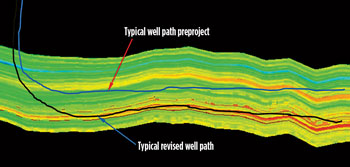 |
| Fig. 4. Typical preproject well path shown in subsurface model and a revised well path based on keeping the wellbore within the higher quality reservoir. |
|
Detailed completion review. The subsurface model significantly improved reservoir knowledge and enabled the team to perform a detailed review of completion designs and production performance. This project began with a review of existing wells, incorporating more rigorous analysis and interpretation to help create a path forward.
Production history matching. The reservoir simulation model was used to integrate geology and geophysics information carried by the subsurface model, fracture model and flow mechanism. When calibrated to production data, the simulation model acts as a prediction tool for decision-making. Factors important for history matching can also highlight the requirement for better data collection. Similarly, completion and production strategies can be devised using an uncertainty approach.4
History matching was conducted on a pre-existing well within the region that had approximately 400 days of production history, with accompanying directional survey, completion and hydraulic fracturing data. A Peng-Robinson equation of the state-based pressure/volume/temperature (PVT) model, derived from fluid samples in nearby wells, created the PVT tables necessary for the compositional simulation runs used during history matching.5 Post-frac modeling of hydraulic fracturing, with appropriate pumping schedules, pressures and rates, was used to obtain important properties of the hydraulic fractures integral for the reservoir simulation.
The reservoir simulation model was built, using a cut-out of the subsurface model around the well. Local grid refinement, with logarithmic gridding between adjacent fractures, accurately represented the fractures. Additional reservoir properties necessary for reservoir simulation were obtained from the earth model, petrophysical analysis, and core analysis data available with the operator. Figure 5 depicts the gas flowrate match, between the simulated and observed historical data, for a study case in which a minimum gas flowrate was a constraint. Finally, Fig. 6 shows the simulated flowing bottomhole pressure (FBHP) data, plotted against the historic FBHP data.
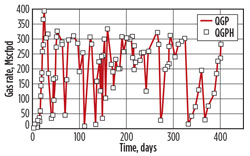 |
| Fig. 5. Gas rate (constraint) match between simulated (QGP, red line) and historical (QGPH) data. |
|
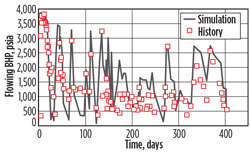 |
| Fig. 6. FBHP match during history matching. |
|
History matching of this well showed poor communication from the well to fractures. Upon closer review, it was confirmed that much of this wellbore was above the clay-rich geohazard, making it extremely difficult to sustain a conductive fracture between the wellbore and best-quality reservoir section. To realistically match the modeled fractures to the observed well production, the extent of fracture conductivity damage was within the range of 97%, which confirmed the need for refined well placement and also prompted a redesign of the fracture stimulation treatments.
Complex fracture network simulation. A new-generation complex fracture network simulation tool was tested and evaluated during this stage, to gain insight into the region’s fracture complexity.6 This can best be described as a Generation 1, discrete element, solid mechanics tool that models fracture growth behavior as a function of applied, net treating pressure. This tool has the advantage of being very fast in its calculations, but it does not fully account for fluid propagation and proppant transport throughout the fracture network.
A basic, natural fracture pattern was used in the complex fracture network simulator. To create this fracture network, openhole image log data captured for each well were used, combined with microseismic information obtained during fracture stimulations on a pad just to the south.
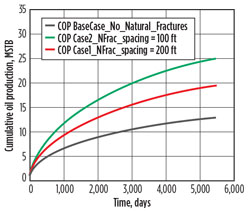 |
| Fig. 7. Comparison between the two natural fracture cases and base case shows that the presence of natural fractures can result in almost twice the amount of oil recovered during the base case. |
|
Fracture sensitivity analysis. One of the necessary methods for evaluating unconventional reservoir performance involves numerical simulation. The ideal workflow involves building an earth model and cutting out a section around the wellbore(s), and history matching by changing the uncertainty parameters until a reasonable match is obtained between historical and predicted data, which is then used to predict performance. Because the history-matching process can arrive at multiple non-unique solutions, it is often necessary to conduct a sensitivity study beforehand.
A sensitivity analysis was conducted for a well on which subsurface modeling and post-frac analysis data were available. A post-frac analysis, using appropriate pumping schedules, pressures and rates, obtained properties of the hydraulic fractures that became an integral part of the reservoir simulation model. The post-frac analysis predicted 37 fractures for the well’s 13 frac stages. A reservoir simulation model was built around the wellbore, using data extracted as much as possible from the subsurface model built for the reservoir, and incorporating the fracture attributes from the post-frac analysis.
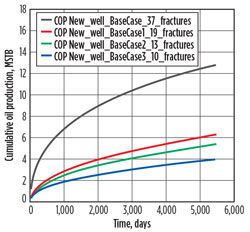 |
| Fig. 8. Comparison between the two natural fracture cases and base case shows that the presence of natural fractures can result in almost twice the amount of oil recovered during the base case. |
|
Because fluid composition data and test reports were available for this, as well as several other wells within the same reservoir, PVT tables were created from a common equation of a state model (Peng-Robinson-based) that captured the effects of fluid property variation within this mostly gas condensate-rich reservoir. A fully compositional numerical simulation was run for 15 years, for all of the sensitivity cases selected. These cases included sensitivities to matrix permeability, number of fractures created, wellhead pressure, condensate-to-gas ratio (CGR), and the presence of natural fractures to simulate fracture complexity.
The sensitivity study revealed that the matrix permeability has the largest influence on oil rates, followed by fluid composition (CGR) within the range chosen, then the spacing of natural fractures (depicting fracture complexity, Figs. 7-8), the number of hydraulic fractures, and wellhead pressure. Some of these findings are similar to those reported by Kumar et al. in another liquids-rich shale play.
This was of significant interest to the team because increasing the number of fractures, as well as the degree of fracture complexity, had a significant effect on the liquid production rates simulated. Because these were variables that could be affected by team decisions, potential changes to both the wellbore completion plan and fracture stimulation designs were reviewed extensively. This resulted in some very significant completion design changes to more effectively place proppant into some of the very narrow fractures of the complex fracture network. Also, the addition of more perforation clusters per stage, along with a newer product that provides temporary near-wellbore (NWB) diversion, was identified as an approach to increasing the connected fracture area and improving liquids productivity.7
Completion design changes. Previous work performed in this field, combined with forward modeling and sensitivity testing, provided a tremendous amount of information that was reviewed and evaluated, and ultimately conformed to design changes that could be implemented easily on location, Table 1. Areas identified for potential improvement included:
- Address lateral and perforation cluster placements.
- Minimize NWB damage and loss of conductivity.
- Modify the treatment schedule, to improve results within complex fracture systems.
- Optimize the net treating pressure, to improve proppant placement.
- Ensure all perforation clusters open, at some point during each treatment stage.
| Table 1. Summary of completion design changes. |
|
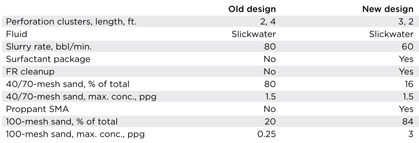
|
Solutions/changes included:
- Adjust lateral target to a higher, reservoir-quality rock; select cluster location based on lateral log data.
- To improve NWB conductivity, use surface modification agent on the tail-in proppant8, and incorporate the friction reducer clean-up package.
- Begin 100-mesh proppant early, to enter secondary fractures when they are at their maximum width.
- Increase proppant lb/gal, to drive higher net pressure increase.
- Add NWB diversion stages, to promote more open clusters.
Summary of results. The application of this process required a significant amount of time and effort from both geoscience and engineering perspectives. It was implemented while drilling and completion operations were ongoing in the field, making it possible to compare results from before, during and after well placement and completion design recommendations were made. For this article, estimated ultimate recovery (EUR) was used to measure well performance, based on early production, and projected into the future. While this process is not perfectly accurate, the consistent approach incorporated here provides a realistic comparison of well performance. Figure 9 illustrates EUR results, where the values have been normalized to the best pre-project performing well. While early results were very positive, some problems were encountered:
Well A: This well was kicked off early in the reservoir’s hot shale section, and only about 30% of this well was actually located within the higher-quality reservoir section. However, knowing this before production was beneficial.
Wells B, C, D and E: These wells were all drilled within a portion of the reservoir, in which there was no strong barrier to stop the fracture treatment from growing into a wet zone. This was identified as a possible concern, when a pilot hole was drilled for Well D. Although these wells did not perform well in terms of hydrocarbon production, they all produced significant quantities of water, suggesting that a conductive fracture system had been created. At this point, well targets were raised slightly, remaining within the higher-quality reservoir but staying near the top to avoid fracturing into the water.
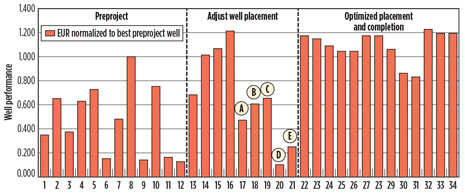 |
| Fig. 9. Well performance results showing normalized EUR for each well in the order drilled and completed during this development. |
|
Based upon the reservoir simulation work performed during the project’s completion optimization portion, increased oil productivity was another measurement of success. Of the wells completed, the final well was the one in which the fully optimized treatment designs were pumped. Figure 10 illustrates the production results for approximately two years from the best pre-project producing well. Figure 11 shows the production results, for about four months, from the final well in the dataset.
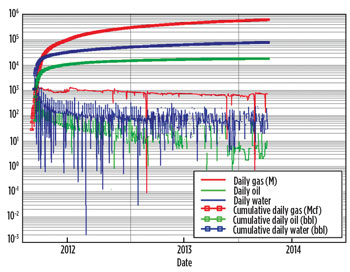 |
| Fig. 10. Production results from the best performing preproject well. |
|
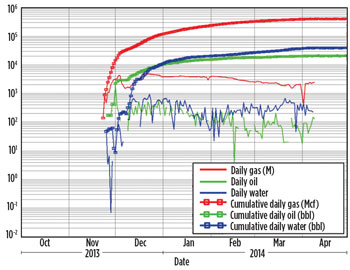 |
| Fig. 11. Production results from the final well in the dataset. |
|
Comparing the data, the final completed well reached the same cumulative oil volume within four months that the pre-project well achieved within 50 months. It is still sustaining significantly higher daily oil production rates. Additionally, the final well is producing significantly higher gas rates, which are also being sustained. These early results are very strong evidence that the reservoir simulation work used to support the changes implemented into the optimized completion designs has improved liquids production rates from this complex reservoir.
Because this project incorporated a vertical pilot hole, and the collection of core and open-hole logs for both the vertical well and horizontal lateral within this well, some comparisons of well construction and completion costs should also be factored into the success criteria. To do this, the drilling and completion costs were divided by the gross perforated interval (GPI), in feet, to provide a realistic comparison of the cost normalized to the lateral length. The pre- and post-project costs were then averaged, and the cost results summarized:
- Pre-project well cost: $1,113/GPI
- Post-project well cost: $1,061/GPI.
Based upon this analysis, the cost of the post-project wells, including data acquisition and completion changes, was approximately 4.7% lower than the pre-project wells. Although additional data were acquired, and significantly more proppant was placed into the new wells, the reduced treatment rate, reduced water volumes, and improved drilling and operational efficiency combined resulted in a lower overall cost per well. 
ACKNOWLEDGEMENTS
This article is adapted from a paper presented at the Unconventional Resources Technology Conference, held in Denver, Colo., Aug. 25–27, 2014. The authors thank the management of Devon Energy Corporation and Halliburton for permission to publish this work. The authors also thank Eric Hart, Rusty Werline, Geoff Spade, Eric Holderby, Ian Adams, Ken Williams and Carlos Davila for their contributions and support to this project.
REFERENCES
- Dusterhoft, R., K. Williams and A. Kumar, et al. “Understanding complex source rock petroleum systems to achieve success in shale developments,” SPE 164271, presented at the 18th Middle East Oil and Gas Show and Conference (MEOS), Manama, Bahrain, March 10–13, 2013.
- Dusterhoft, R., A. Kumar and S. Siddiqui, et al. New processes and tools for design and execution to optimize hydraulic fracturing treatments in shale reservoirs. SPE 168583, presented at the SPE Hydraulic Fracturing Technology Conference, The Woodlands, Texas, February 4–6, 2014.
- Browning, J., S. W. Tinker and S. Ikonnikova, et al. “Barnett shale model-1: Study develops decline analysis, geologic parameters for reserves, production forecast,” Oil & Gas Journal, 111 (8), 2013.
- Kumar, A., R. Dusterhoft and S. Siddiqui, “Completion and production strategies for liquids-rich wells in ultra-low-permeability reservoirs,” SPE 166177, presented at the SPE Annual Technical Conference and Exhibition, New Orleans, La., Sept. 30–Oct. 2, 2013.
- Peng, D. Y., and D. B. Robinson, “A new two-constant equation of state,” Ind. Eng. Chem. Fundamen, 15 (1), 1976, pp. 59–64.
- Walters, H. G., and N. Schischka, “Unconventional wisdom,” Oilfield Technology, 6 (3), 2013, pp. 29–33.
- Allison, D. B., S. S. Curry and B. L. Todd, “Restimulation of wells using biodegradable particulates as temporary diverting agents,” SPE 149221, presented at the Canadian Unconventional Resources Conference, Alberta, Canada, Nov. 15–17, 2011.
- Vo, L. K., P. D. Nguyen and J. D. Weaver, “Development and applications of an aqueous-based surface modification agent,” SPE 165172, presented at the SPE European Formation Damage Conference and Exhibition, Noordwijk, The Netherlands, June 5–7, 2013.
|














